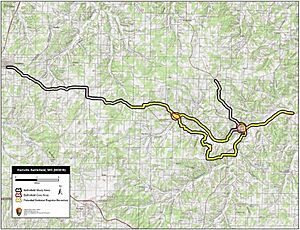Battle of Hartville facts for kids
Quick facts for kids Battle of Hartville |
|||||||
|---|---|---|---|---|---|---|---|
| Part of the Trans-Mississippi Theater of the American Civil War |
|||||||
|
|||||||
| Belligerents | |||||||
| Commanders and leaders | |||||||
| Samuel Merrill | John S. Marmaduke | ||||||
| Units involved | |||||||
| Southwestern District of Missouri Troops | 4th Division, I Corps, Trans-Mississippi Department | ||||||
| Strength | |||||||
| ~750 | |||||||
| Casualties and losses | |||||||
| 78 total 7 killed 64 wounded 7 missing or captured |
111 total 12 killed 96 wounded 3 missing or captured |
||||||
The Battle of Hartville was a fight during the American Civil War. It happened from January 9 to 11, 1863, in Wright County, Missouri. This battle was part of a larger plan by Confederate General John S. Marmaduke to raid into Missouri.
Contents
Why the Battle Happened
In early 1863, Confederate General John S. Marmaduke led a raid into Missouri. His plan had two main parts. One group, led by Colonel Joseph C. Porter, left Pocahontas, Arkansas. Their goal was to attack Union posts around Hartville, Missouri.
Confederate Movements
On January 9, Porter's men got close to Hartville. They sent a small group ahead to check things out. This group managed to capture the small Union army post there. Later that day, Porter moved his troops towards Marshfield. On January 10, some of Porter's soldiers raided other Union places nearby. They then met up with Marmaduke's main group east of Marshfield. Marmaduke had heard that Union troops were trying to surround him. So, he got ready for a fight.
Union Response
Also on January 10, Union Colonel Samuel Merrill led a group of soldiers from Houston, Missouri. They arrived in Hartville that morning. Merrill found out that the small Union post had already given up. So, he decided to head towards Springfield. His troops set up camp near the Gasconade River. Early on January 11, Porter's Confederate soldiers found Merrill's scouts. A small fight, called a skirmish, began.
Who Fought in the Battle
The battle involved soldiers from both the Union and Confederate armies.
Union Forces
Colonel Samuel Merrill led the Union soldiers. His forces included:
- Soldiers from Illinois and Iowa.
- Cavalry (soldiers on horseback) from Iowa and Missouri.
- A small group of artillery (soldiers with cannons) from Missouri.
Confederate Forces
Brigadier General John S. Marmaduke led the Confederate soldiers. His forces included:
- Two main groups, called brigades, led by Colonel J.O. Shelby and Colonel Joseph C. Porter.
- Several cavalry regiments from Missouri.
- A small group of artillery from Arkansas.
The Battle Begins
General Marmaduke thought he was being attacked by several Union groups. So, he sent Porter's and Shelby's soldiers on a different road towards Hartville. Meanwhile, Colonel Merrill saw this movement. He marched his Union troops straight to Hartville. Merrill's men took a strong defensive spot on high ground west of the courthouse. This spot was good for defense because it had cover.
Fighting in Hartville
Shelby's and Porter's Confederate brigades tried to push Merrill's Union forces out of their strong position. But the Union soldiers were too well-placed. For about four hours, the Confederates attacked several times. Each time, the Union soldiers fought them off. Eventually, Merrill pulled most of his troops back. However, about a third of his men, led by Lieutenant Colonel Dunlap, didn't get the order to retreat. They stayed on the battlefield until nightfall.
What Happened After
As night came, both sides saw the other leaving the battlefield. Because of this, both the Union and the Confederates claimed they had won. The actual outcome was a mix of wins and losses for both sides.
Union Perspective
From the Union side, they felt they had won because they stopped Marmaduke's attacks. They also caused many casualties (injuries or deaths) among the Confederates. However, the Union soldiers had to leave the battlefield.
Confederate Perspective
From the Confederate side, Marmaduke had managed to bring his groups together. He also made sure his path to retreat was safe. He set up a hospital in Hartville and controlled the town for a short time. But he had to quickly retreat back into Arkansas. The attacks had also caused many important Confederate officers to be killed or badly wounded. These included Colonel Joseph C. Porter, Colonel Emmett MacDonald, Lieutenant Colonel John Wimer, and Major George R. Kirtley.
Impact of the Raid
Marmaduke's raid caused a lot of trouble for Union forces in the area. Many small Union posts were taken over, destroyed, or left empty. However, a major Union supply center in Springfield stayed in Union hands. Even though the Confederates had to retreat, their ability to move quickly and escape showed that Union-held Missouri could be vulnerable to future raids.
Images for kids



